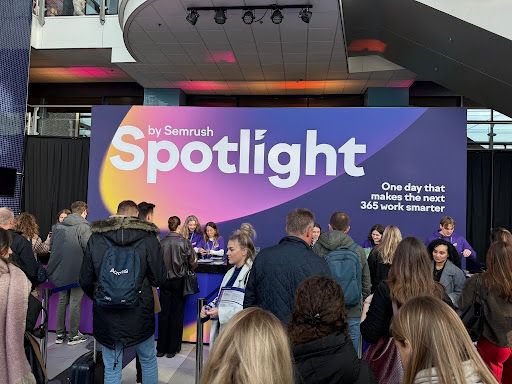Okay, let's be honest—AI Overviews (AIOs) have bulldozed through the marketing landscape like a caffeinated rhinoceros, trampling keywords, traffic, and sanity alike.
For marketing beginners (and even for some CEOs), it’s probably a shocking situation. But for those of us who’ve been in the industry long enough... we’ve seen shifts like this before. And the only solution here is:
- Start measuring
- Produce hypotheses
- Test
- Repeat
Now, I urge you—don’t panic. Your heart should be as cold as yesterday’s coffee, because all you really need to do is follow well-known marketing principles and step into a new, rising universe called Generative AI Optimization (GAIO).
Yes, the robots might be calling the shots now, but I’ve got the map, the flashlight, and the secret shortcuts to help you navigate this brave new marketing world.
Let’s dive into what’s trending in 2025—and how you can not only survive but thrive amidst the AIO chaos.
Challenges or How AI Decided to Crash the Marketing Party
So, let’s have a candid chat about the challenges of AI Overviews (AIO). If your brand has been feeling oddly invisible lately—almost like Google invited a cooler guest to the party and left you awkwardly standing by the snack table—well, you're not alone. AIO is shaking up the digital dancefloor, and the numbers don’t lie.
First off, traffic drops of 20–40% have been reported in search results impacted by AI Overviews. The number of queries triggering these AI Overviews isn’t just growing—it’s skyrocketing. Between January and March 2025 alone, the number of AIO-triggered queries more than doubled on US desktops.
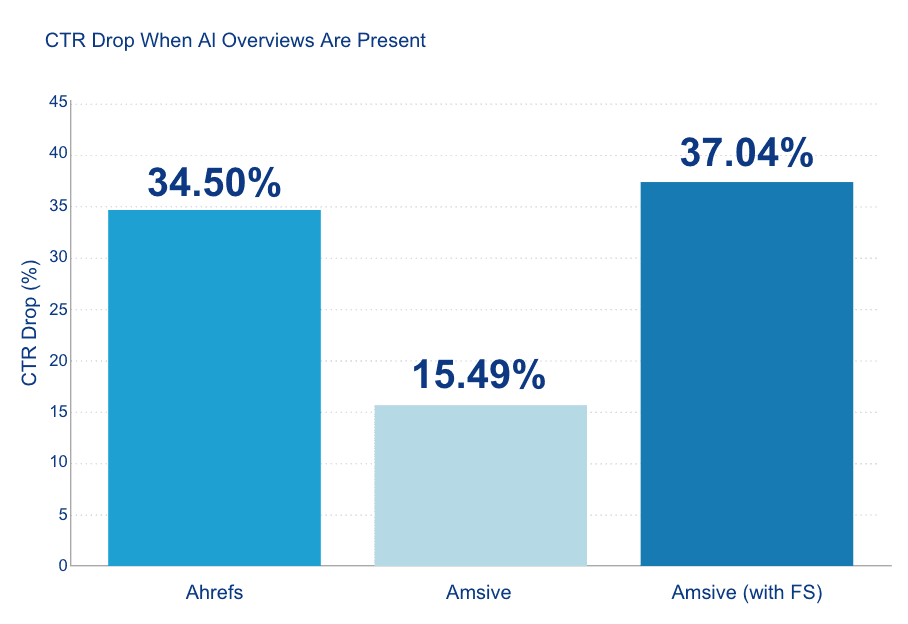
AI Overviews have also been cutting organic clicks by nearly 35% on average. Ahrefs pointed out a painful 34.5% drop in click-through rates (CTR) for first-position listings when AIO appeared, based on a massive analysis of 300,000 keywords. Meanwhile, Amsive confirmed an average 15.49% CTR drop, with some extreme cases hitting a 37.04% decline—especially when AIO cozied up with featured snippets.
User behavior is shifting faster than fashion trends. Google’s new AI Mode is changing how people interact with search, encouraging them to settle for AI-generated summaries and reducing the need to click through. Funny enough, it’s like Google AI handed users a comfy armchair right outside your digital storefront—and convinced them there’s no reason to step inside.
For non-branded keywords, things look even gloomier. Amsive recorded a nearly 20% CTR decline, and Ahrefs reported a hefty 27% drop for informational queries.Interestingly though, branded keywords seem to enjoy a weird little AI boost—around an 18.68% CTR increase.
But that’s something we’ll dig into later. Because when you look closer at traffic drops, you’ll notice they hit hardest on informational intent keywords.
Yes, the days when you could crank out tons of blog posts answering questions like “What is...” or “Why should...” have vanished into the mist… Maybe it’s time to revisit your content strategy—and start trimming down the number of informational-intent keywords you’re targeting?
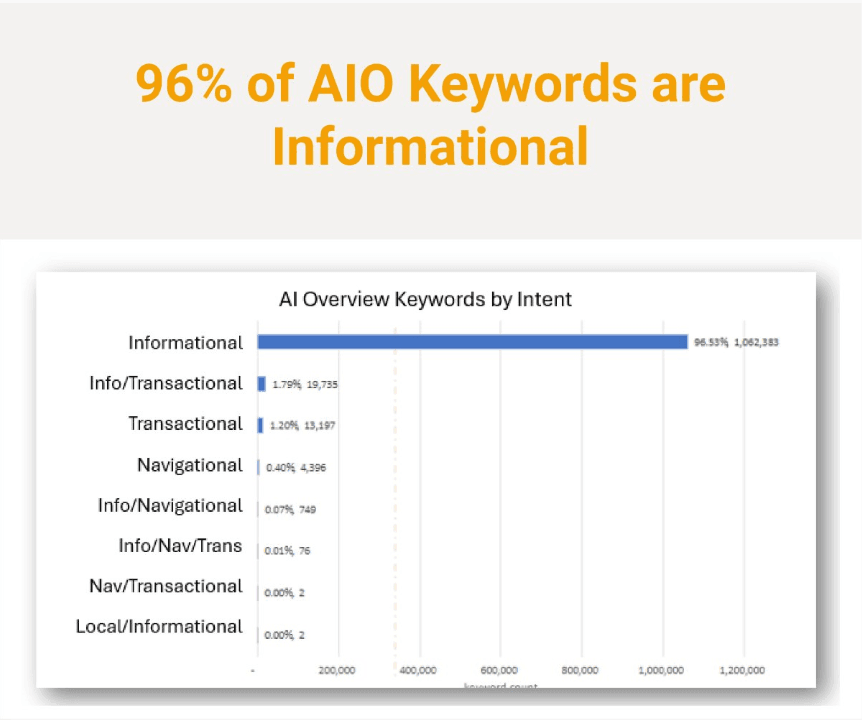
Gen Z Doesn’t Scroll—They Just Ask AI
Data from early 2025 reveals something astonishing: 82% of Gen Z occasionally use AI chatbots, compared to only 42% of Baby Boomers. Even more striking, when faced with a choice between traditional organic search results and AI Overviews, Gen Z chooses AI nearly half the time—42%, to be exact.
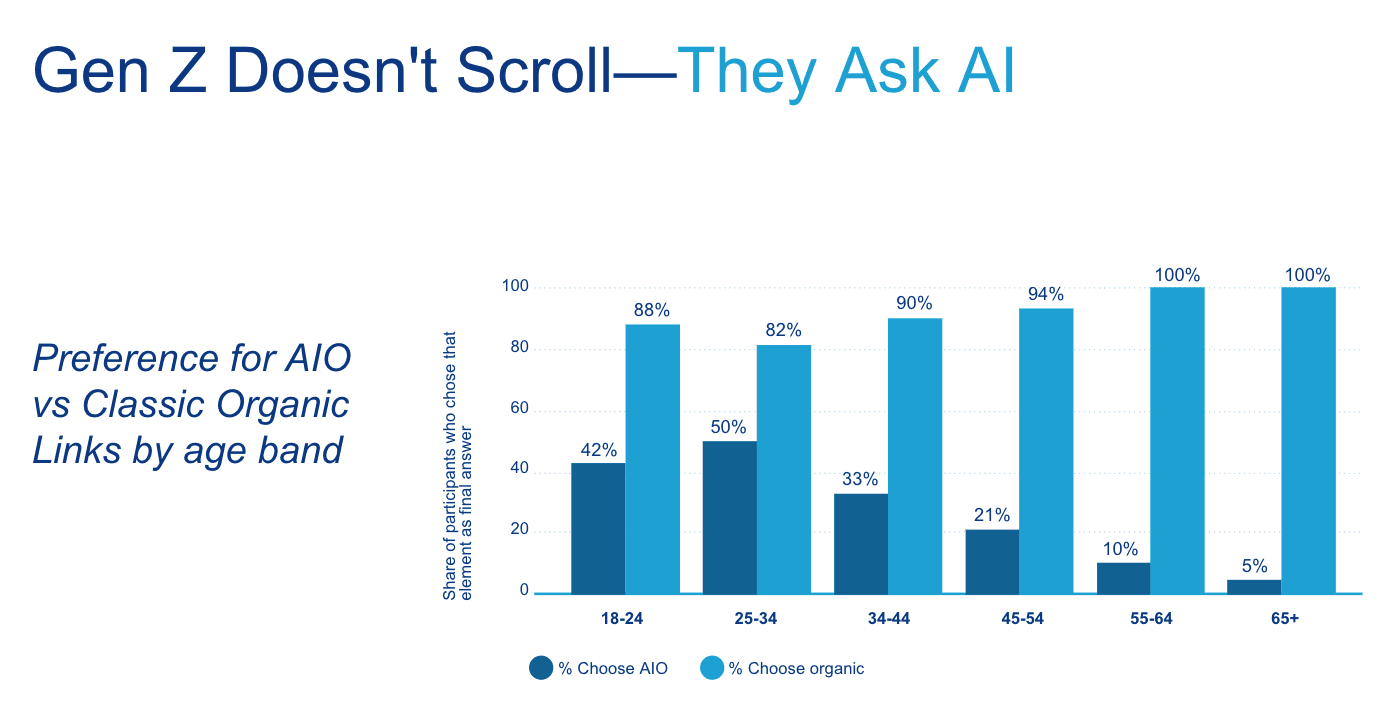
Older generations? Not so much. Only 5–10% of users aged 55+ prefer AIO.
And it’s not just chatbots. Multimodal searches—like Google Lens visual queries or Meta’s Ray-Ban smart glasses—are exploding. Google already logs 10 billion searches per month via Lens alone, signaling a clear shift toward visual and AI-driven interactions. If your brand hasn’t caught up yet, it’s officially time to get moving—or risk becoming the digital equivalent of dial-up internet.
Simply put, Gen Z doesn’t browse—they ask, they watch, they interact.
So the next time you’re optimizing your content, remember: your next big audience isn’t scrolling. They’re chatting with their new “best friend” —AI.
Generative Search is Shaping, Not Replacing, the Customer Journey
But here’s some good news—it’s not all chaos. While generative search is clearly reshaping the marketing landscape, it hasn’t replaced traditional approaches. Instead, it’s evolving the customer journey, offering new entry points and fresh ways for brands to connect with users.
In traditional search, the customer journey often starts at your website, moves through email, and eventually leads to a sales page.
Today, with generative AI search, the journey begins differently. Customers now frequently start directly within AI-driven search environments like Google’s AI Overviews or ChatGPT.
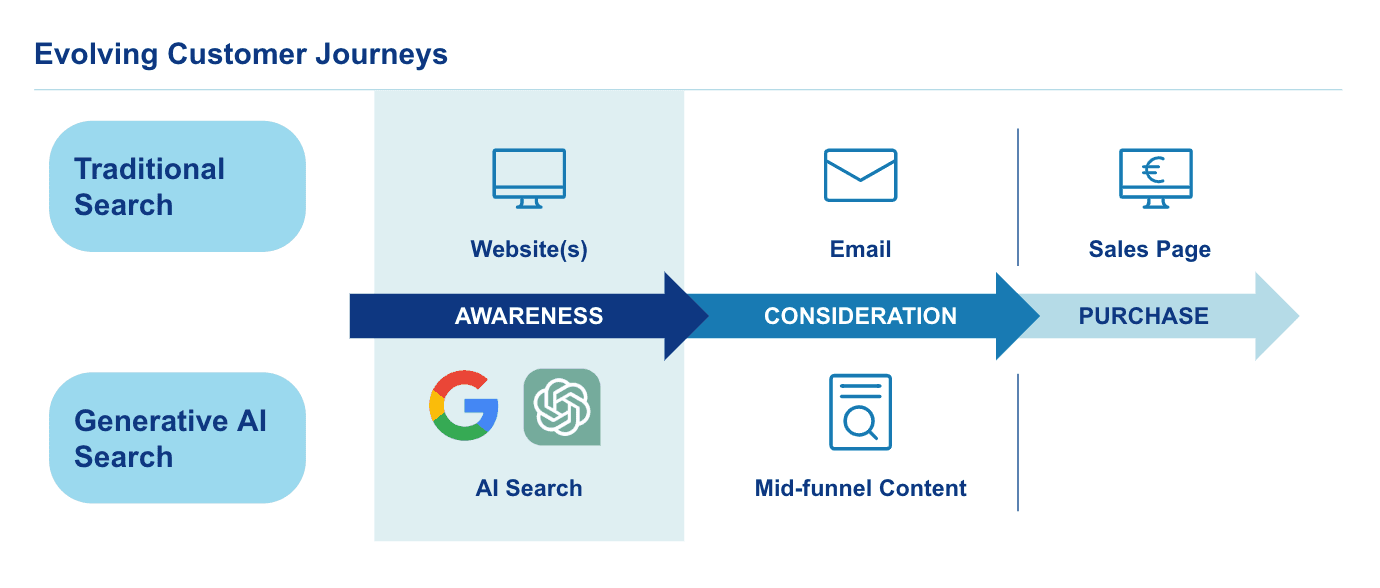
But don’t panic—this doesn’t erase the marketer’s role; it simply shifts our involvement further down the funnel.
The awareness stage, once dominated solely by websites, now increasingly features AI-generated overviews. That means your best content—once proudly displayed on your homepage or blog—must now also be optimized to perform well in generative AI environments. As customers move into the consideration stage, mid-funnel content like detailed guides, product comparisons, and customer testimonials becomes even more critical. This content not only engages but also helps ensure your brand stays part of the conversation, guiding potential customers toward a purchase decision.
In short, generative search hasn’t removed the need for effective, engaging content—it has amplified it.
SEO vs GAIO? SEO AND GAIO!
When we compare traditional SEO with GAIO, we quickly see that while both aim to improve visibility, they operate in fundamentally different ecosystems—SEO targets search engines and rankings, while GAIO focuses on optimizing for AI-driven environments like AI Overviews and chat interfaces.
This table breaks down the key differences:
| SEO | Shared (SEO & GAIO) | GAIO |
|---|---|---|
|
|
|
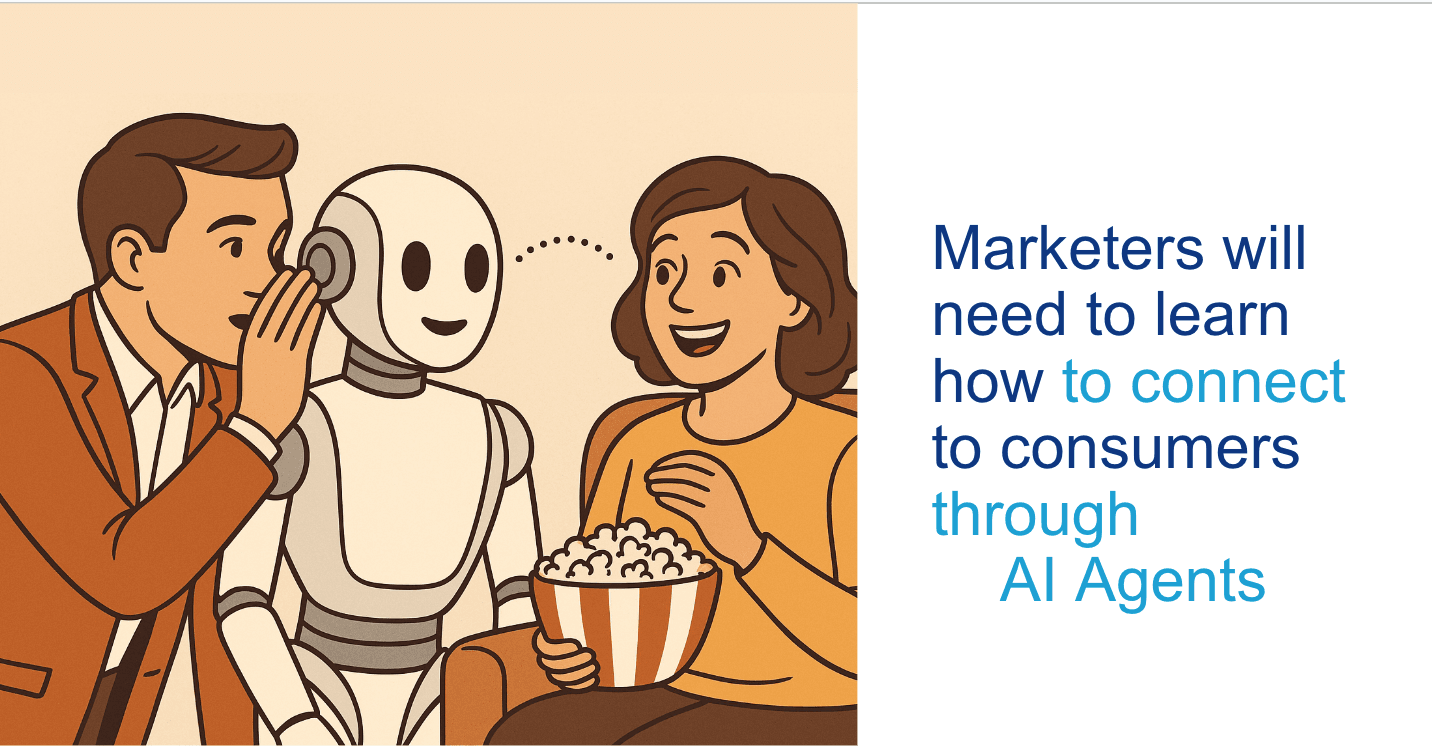
Changing Roles in Marketing: Navigating the New Skills Landscape
As generative AI reshapes customer interactions, marketers find themselves in a significant transformation. To keep up, it’s not just the tools that must evolve—it’s the marketers themselves.
Recent data shows a clear shift in user behavior once AI Overviews (AIO) are introduced. Traditionally, users clicked on organic results 57% of the time after leaving Google. With AIO, that drops dramatically to just 40%, signaling a substantial decline in traditional organic traffic. At the same time, there’s a noticeable surge toward community-driven content and video platforms, with engagement rising from 18% to 30%. Users also show a modest increase in preference for shopping platforms—from 10% to 15%—reflecting AI’s growing role in influencing consumer decisions.
These shifts call for new types of marketer profiles:
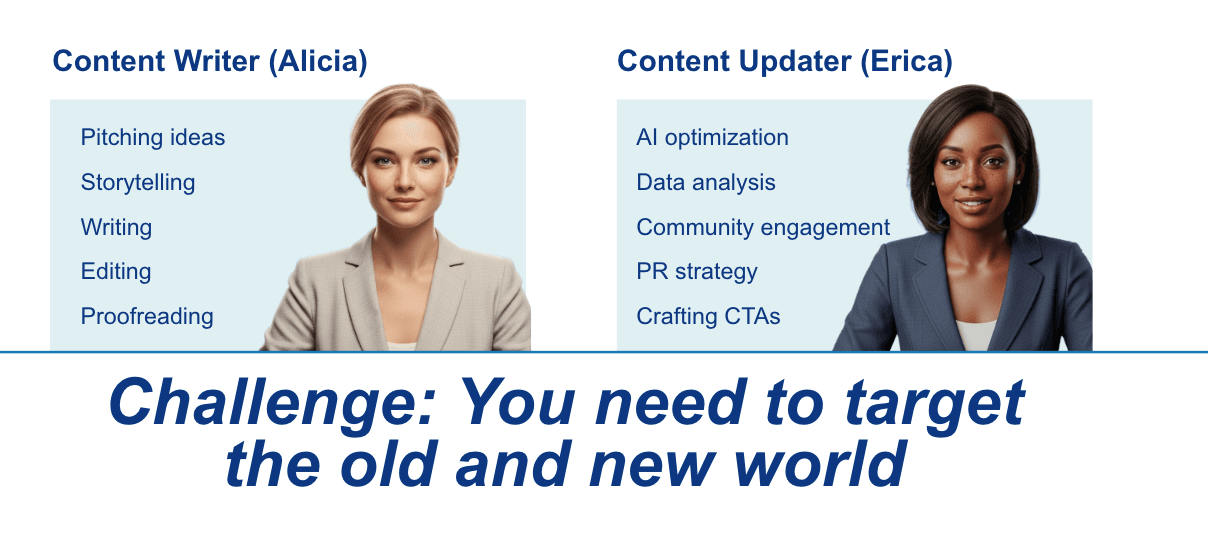
Traditional Content Writers ("Alicia") typically focused on storytelling, pitching ideas, writing, editing, and proofreading—While these foundational skills remain valuable, they’re no longer sufficient on their own.
Enter the Content Updater ("Erica")—a role that’s quickly becoming indispensable. Erica specializes in AI optimization, data analysis, community engagement, strategic PR, and crafting CTAs specifically tailored for AI-driven environments.
The challenge—and the opportunity—is clear: today’s marketers must bridge the gap between the “old world” of traditional content creation and the “new world” of generative AI. By combining foundational storytelling skills with AI fluency, marketers can align with evolving customer behavior and stay successful in a rapidly changing digital landscape.
New KPIs for the AI Era: What Marketers Need to Measure Now
As the marketing landscape evolves, so must the way we measure success. Traditional SEO metrics aren't obsolete—but they simply don't tell the full story anymore.
With AI-driven search taking center stage, marketers need to adopt a new set of KPIs to accurately track and respond to changing customer behaviors.
Traditional SEO metrics, still useful, include:
- Keyword Rankings: Your position in traditional search results.
- Search Volume: Monthly searches per keyword.
- Clicks & Impressions: How often your content appears and is clicked.
- Backlinks: The number and quality of external links.
- Traffic from Google Search: Visitors arriving directly from search results.
However, for comprehensive visibility in AI search environments, you need new AI-focused metrics:
- Topic Match: Measures how well your content aligns with the way users ask questions in AI platforms.
- Different Search Intents: Understanding the variety of ways users phrase questions or seek information through AI.
- Brand Mentions: How frequently your brand is mentioned and linked in AI-generated answers.
- AI Citations: Recognition of your website as a trusted source within AI responses.
- AI Bot Visits: Frequency of AI-driven bots indexing and accessing your content.
How to Thrive in the AI Era: 3 Actions to Stay Competitive
Navigating the rapidly evolving landscape of generative AI search may feel daunting, but success comes down to these three crucial actions:
1. Boost AI Visibility
- Ensure your brand and products have high visibility across the web, social platforms, and beyond.
- Expand your content creation to be truly omnichannel, utilizing multimedia elements to strengthen your presence in AI-driven environments.
- Stay alert to emerging platforms and channels, such as Roblox, Uber, or other innovative spaces, to proactively position your brand.
2. Deliver On-Demand Content
- Adapt your processes to produce more content at greater speed, without sacrificing quality.
- Move swiftly to capitalize on emerging trends and capture audience interest early.
- Embrace the dominance of short-lived content on social media, and refine your strategy accordingly.
- Optimize your website and content to align seamlessly with evolving customer interactions (AI chatbots, AI search experiences, personalization, and multimedia content).
3. Consider AI Agents as Customers
- Treat AI agents as the new representatives of your customers—catering specifically to how AI platforms interpret and deliver your content.
- Establish a robust technical foundation, ensuring your content and products are easily accessible and quotable by AI agents, maximizing your presence within AI-generated results.
But how do you actually achieve all of that?
Well, there’s really only one approach. Remember?
- Measure
- Produce hypotheses
- Test
- Repeat
You already have the tools to measure your brand’s presence in AI Overviews and other LLMs like ChatGPT. Platforms like Ahrefs, Sistrix, and Semrush are already tracking that kind of stuff. You’ve got the brainpower to come up with smart hypotheses—and AI tools or agents to help you produce content fast. And when it comes to testing, you’re covered too. Use tools like SearchPilot or seoClarity to run proper A/B experiments.
All you really need is the drive to repeat this cycle—again and again—until you win.






